Another major Elvenar event – Evolution of the Phoenix – is here, and it is time to do some analysis of what strategies we can employ, and what can we get out of that. We’ll take a look at several approaches, and see how they impact not only ability to get grand prizes and daily prizes, but also all other rewards that come from event chests.
We will also be able to answer perennial question of how well did you do in the event, or how likely a particular outcome is. Because everyone wants to know how many people did worse than them 😉
Table of Contents
Intro (also TL;DR)
So let’s do some science, shall we? If that’s not your thing, then you can do some selective reading. Take a look at the Setup section, in particular Strategies definitions. Without knowing what strategies we’re comparing the rest is not very meaningful. Then you can take a look at distribution tables in the Detailed Distribution Analysis for particular rewards. You don’t need to pay attention to charts there if that’s confusing. Or you can skip straight to the Best Strategy? section if all you want to know is which chests to open. That’s where we summarize results for 3 strategies, and provide some recommendations. Keep in mind that you will be missing insights on variability of results.
So let’s jump right into it.
* – * – *
April/May 2019 brings us a new major event in the world of Elvenar – Evolution of the Phoenix. I won’t be repeating much of what is written elsewhere, so check out these resources:
- Thorough description of the event, mechanics, quests and prizes at Elvenar’s Gems of Knowledge: Evolution of the Phoenix
- Handy spreadsheet of quests and prizes by TomatoeHu: www.tinyurl.com/phoevo. All credit goes to her!
Instead, we will focus our analysis on choices, and more importantly potential outcomes of those choices over the course of the event. We look at several strategies, and see what we can expect as a result.
Keep in might that your individual results might be quite different from the expectations outlined in this analysis. That’s probability and statistics for you 😉
Setup
Chests
So, let’s quickly reiterate the setup. There are 9 different chests out there, that need different amounts of essence to open. Here is a summary:
There are always 3 chests available at any time. Once you open one of them, another 3 will be drawn at random (presumably). And every time you open a chest, you get guaranteed number of feathers (grand prize tokens), and one of the chest prizes at random (see the table above). This sometimes includes a chance for extra essence.
Once you accumulate 20 feathers, you get the next Grand Prize in the sequence. This time the sequence looks like this:
It is looping, so once you reach the last grand prize on the list, you start with the first one again. One caveat though – only first 20 grand prizes cost 20 feathers. Starting from GP #21 (i.e. Phoenix Artifact #11), you need 30 feathers to get the next grand prize. Generally, it is only relevant for players who paid for extra essence one way or another, as with maximum amount of essence possible for free it is practically impossible to reach 30 feathers tier.
Essence
You get essence by completing main line quests (up to 65 essence per quest, can be done one right after another), daily quests (35 essence per quest, one quest a day only), as well as picking 1-3 essence dropped randomly around the city (hourly intervals, up to 6 drops max).
So how much essence you can get for free? Well, here is an optimistic calculation:
As long as you complete all the quests, the essence from quests is guaranteed. City essence assumes that you pick up 24 essence a day from the city. This is difficult to do as there are only 24 drops a day, with mostly 1 essence each. But it is not impossible. So for our calculation we will use 7,000 essence as a base maximum, and later on we can show how you can adjust this if you deviate from that number. Note, that this does not include essence from the chests as this will be taken care of as part of the simulation (so the actual essence spent will likely be higher than 7K).
Strategies
Alright, so now that the general mechanics is clear, we can talk about the strategies. Generally, most players would want to focus either on maximum number of grand prizes, or maximum number of daily prizes (either one or several). Nothing really prevents someone to focus on any other reward that you can get from the chests, but this is quite rare. We didn’t include any of those strategies in this analysis.
When we talk about strategy for opening chests, all we really mean is a priority sequence for the chests. You get your 3 chest selection, and then you always pick the one that has the highest score as per your strategy. With that, we were looking at these 3 strategies:
Strategy G
Focus on grand prizes: this is a strategy that focuses on maximization of the number of grand prizes (by maximizing feathers). For this strategy, you want your chests to have the maximum feather output per essence spent, and the pecking order is as following:
Strategy D
Focus on daily prizes: this is a strategy that focuses on maximization of the number of daily prizes. For this strategy, the best chests would have the maximum number of daily prizes per essence spent, and the order would look like this:
In both cases, we have taken into account that some chests have a chance of giving some of the essence back, thus improving attractiveness of such a chest (i.e. reducing cost attached).
Strategy H
As you can see the top two chests in strategy G are one of the two worst chests in strategy D (I am talking about cheapest chests – light wood and dark wood). But the purple chest is pretty good in both cases (scores of 3 and 1). So the third strategy is a hybrid: primary focus is on the grand prizes, but bumping purple chest from 3 to 1. The idea is to improve chances of daily prizes without sacrificing too much from the grand prizes perspective. We’ll see if it actually makes sense in practice.
So here is a hybrid strategy:
Summary of Strategy Definitions
And here is a strategy summary:
Simulation Results
Alright, so we’ve got some essence, we defined our strategies, we know the mechanics – it is time to fire up a simulation and go to town. The simulation will recreate the whole event mechanism – create random chest draws, pick a chest according to a specific strategy, get random draws of chest prizes with appropriate probabilities etc. Rinse and repeat until all essence is gone, and see how much of different stuff did we actually get. That’s one scenario, and as we all know it can be all over the place. So we run many scenarios over and over again, and aggregate the results. By many, I mean something like 10mm, to make sure that the results are pretty representative.
Expected Values
And the results are in. Drum-roll! So here we go:
Bu-bu-but I’ve got significantly less than that! (No one ever complains about getting more than expected 😉 ). Well, it happens. Maybe. Remember, these are expected values. By expected it means that over many scenarios (like 10mm, or something like across all Elvenar players) that’s the amounts that we expect to get on average. But every one of us is running just a single scenario (well, per city). Your results can be quite different from those numbers, and in a way this would also be expected 😉
Variability
So let’s look at potential variability of these results.
For most of the desired prizes – grand prizes, chest prizes – it makes sense to look at them from a context of the total essence spent. I.e. we have 7,000 essence to play with, how much of everything are we going to get on average after we’ve spent the whole amount?
The exception to that is daily prizes. For daily prizes, we may want to see how spending smaller amounts of essence impacts our results. The reason being that total number of daily prizes is not fungible if you want more than 1 kind of daily prize. To illustrate, if you wanted 2 different daily prizes and expected total number was 10, if you get 0 of one and 10 of the other you’re bang on in terms of expected number of daily prizes. But this is probably not that you were aiming for…
Smaller Amounts of Essence
So, just for daily prizes we will look at how variability changes when you reduce the amount of essence spent. We will look at 3 setups: you’ve spend 700 essence; 2,500 essence and all-in for 7,000 essence. One thing to note: expected values are linear, so if you spend only 1:10 of the essence (700:7,000), you will expect exactly 1:10 of the expected values. This means that comparing probability charts in terms of expected number of daily prizes is confusing as they all would have different means. However, the ratios (number of daily prizes per essence spent) should be comparable. The same is true for inverted ratios that would have an interpretation of average cost per daily prize. So here is how probabilities for the average cost per daily prize looks like for the D strategy with 700, 2500 and 7000 essence spent:
Other strategies look exactly the same structurally (the numbers are different, but shapes and relationships are the same), so we don’t need to look at those.
Intuition?
So what’s the intuition here? It’s rather straightforward. First of all, as we mentioned above the mean values are basically the same. However, the more essence you spend on a particular daily prize, the more likely you’re to be close to the expected value of average cost per daily prize. If you expect to spend ~233 essence per daily prize, this means you would expect 3 daily prizes for 700 essence, and 30 daily prizes for 7,000 essence. However, how likely it is that your average cost would be 700 instead of 233? For 700 essence case, it is actually pretty high – instead of projected 3 you only spin for 1 daily prize, and there you go. This is pretty unremarkable scenario. But for 7,000 case hitting 700 essence/daily prize means you only get 10 daily prizes instead of expected 30. This is theoretically possible, but is extremely unlikely (see the chart above).
So before you go and decide to get many different daily prizes think about that. To get the same number of daily prizes may require very different amounts of essence. In the Essence Adjustments section below I describe how you can translate results for the full 7,000 essence spent into results for different amount of essence (higher or lower).
Detailed Distribution Analysis
Alright, with that aside, all subsequent analysis will only look at the result of dumping all available essence (so ~7,000) and seeing what comes out of this for different strategies.
Grand Prizes
All sections have the same format. The first chart shows probabilities of particular outcomes – in this case, number of grand prizes acquired:
Next chart is a distribution of the average cost per unit – so effectively, is a distribution of an inverse of the above:
Finally, two tables that put some numbers around the shape of the distribution. The table on the left shows probability of getting less than a particular number of units m, by strategy. The table on the right is an inverse of that – what is a number of units m that getting less than such number has a given probability of Pr – also by strategy.
Normally, I wouldn’t worry too much about differences in strategies for grand prizes, as distribution looks pretty tight. You’re almost certain to get between 14 and 18 grand prizes. However, in this particular case getting 15 grand prizes means 8 Phoenix Artifacts. This means evolving one Phoenix to L9, and L9 is important as that’s where Phoenix gets its final bonus production version. And that’s where differences are actually quite noticeable. There is more discussion of the best strategy down in the Best Strategy? section.
Note, that H strategy doesn’t give up much comparing to G strategy as far as grand prizes are concerned.
Daily Prizes
There is a lot more variability in daily prizes – you can realistically get from 15 to 40 daily prizes. Unsurprisingly, D is the best strategy for daily prizes, and G is more than 4 prizes worse on average. H is right in the middle between the two – not as good as D, but noticeably better than G.
Time Boosts
Don’t mind the jagged charts – remember, that underlying distributions are ultimately discrete and not continuous, and certain combinations of outcomes are just more likely that others. It doesn’t change much from the cumulative perspective.
So for time boosts we can see a significant differences between 3 strategies – not just in variability, but in expected values. G strategy dominates here – you can expect more than 2x than from D, and almost 1.5x more than from H. Even if I’d wanted to focus purely on the daily prizes, I dislike how low is a number of time boosts you’d get with the D strategy.
AW KP Instants
G and H strategies are comparable from the AW KP instants perspective, with G being somewhat better. But D is significantly better then either of these strategies, being almost 2x as good as H. Keep in mind though, that variability of AW KP results in D strategy is also significantly higher.
Magical Manufacturing Spells
Again, never mind the oscillations – we ‘re plotting discrete distribution as continuous, hence the artifacts. You can easily see the familiar bell-shaped curves here. Again, we can observe significant differences between strategies here, with H and D now being close, and G is underperforming by quite a bit.
Inspiring Meditation Spells
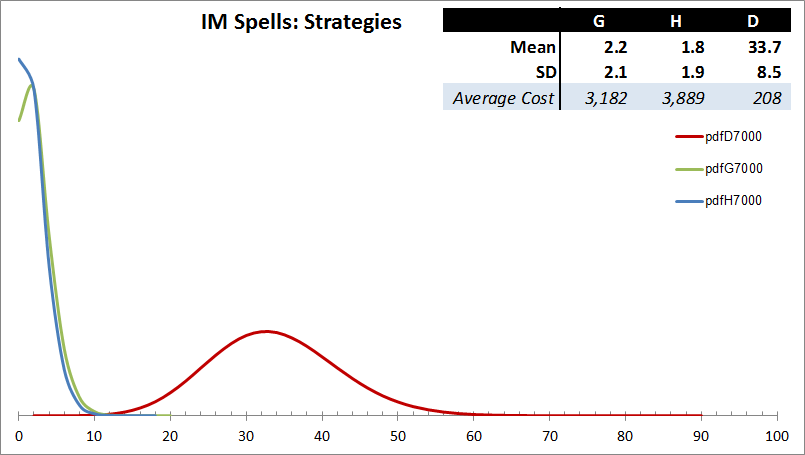
Inspiring Meditations are easy – basically, don’t expect any if you employ G or H strategies. Well, maybe a couple. The only chest with IM is a Green/26 one, and there is literally the only 3 chest combination where this chest will be picked in G or H strategies. As you can imagine, that wouldn’t happen very often.
On the other hand, D strategy will generate quite a few IM spells as the same Green chest is valued as #2 right after the Purple one.
The average cost chart looks weird because the average cost with 0 successes is, well, infinity. Don’t pay attention to that part of the chart 😉
Rune Shards
It’s the opposite situation with the rune shards. Don’t expect any if you’re running D strategy. You can get quite a few with G and H ones, and G is almost twice as good here.
Coin Instants
Another weird chart here – this 33% instant messes things up 😉 Bottom line is, you’re probably going to get 600-800% worth of coin instants – no matter the strategy. D and G look pretty close, and with H you can expect another 100% worth of coin instants extra. But really, who cares? 😉
Supply Instants
Supplies look similar to coins – you’ll get 300-500% worth of supplies instants. H and D look similar (H is somewhat worse). G gets you additional 100% worth of supply instants comparing to H. Still, I don’t think anyone is making chest choices based on coin or supply instants they are getting 😉
Essence Adjustments
Note: Beware, there is some math ahead 😉
Normal Approximation
So how can we expand this analysis to cases when the total number of essence is different from 7,000? Let’s see if our empirical probability distributions look like normal (Gaussian) distributions. And unsurprisingly, normal distribution is a good approximation for number of positive outcome on any of the prizes. Less so with low amounts of essence like 700 (due to skewness), but even then it’s quite acceptable. For higher amounts like 7,000 normal is pretty much bang on. Take a look (this is for daily prizes, but they all look similar):
700 essence, red line is a normal approximation:
2500 essence, red line is a normal approximation:
7000 essence, red line is a normal approximation:
This means that once we know mean and standard deviation of our empirical distributions, we can approximate them with corresponding normal distributions and calculate any other statistics based off that.
Method
So if you want to adjust your measurement to the different amount of essence spent, you need to calculate ratio of new amount of essence to 7,000 used in this analysis. Let’s say this ratio is R. So if you want to run the analysis on 1,750 essence, your R = 1/4. Now you can scale mean from the analysis by R, and standard deviation by square root of R. So running with a quarter of essence will give you a quarter of expected values, but half the standard deviation. So standard deviation goes down slower than the mean, hence distribution becomes more spread out for lower amounts of essence.
Now when you have adjusted mean and standard deviation, you can use corresponding normal distribution to calculate any statistic you’re interested in. Just remember that if you go really low, normal might not be a good approximation anymore.
You also can’t really use this method to calculate distribution of grand prizes of amounts of essence materially higher than 7000. The reason being is that grand prizes become more expensive starting from GP #21 (30 feathers vs 20 feathers), so usual scaling won’t work.
Note, that distributions of average cost per unit are not normal – especially for lower amounts of essence. Take a look and notice how skewed these are:
Again, this is not surprising given that cost per unit is an inverse of number of units.
Real-world Example
So let’s apply this and see how did I do in this event so far. Here are my stats from the daily progress reports (Elvenar Sorcerers & Dragons – Day 09):
Let’s look at all results so far (i.e. ~6.4K essence) vs day 3 (~1.7K essence only):
So you can see that over most of the event (days 1-16 for 6.4K essence) I did alright. Pretty much exactly what’s expected for the grand prizes, and even somewhat better than expected for the daily prizes (I did better than about 2 out of 3 players). None of these numbers are particularly remarkable.
If I just look at day 3 though, it definitely doesn’t look as rosy. It wasn’t too bad for grand prizes (about 40% of players did equally or worse). Remember, that for grand prizes variability is pretty low. But look at the daily prizes on day 3. Ouch! About 90% of players would do better on a day like this. But again, while 10% probability is not great, it is not extreme either. So yeah, it happens. And remember, that over subsequent days I recovered, and ultimately did better than expected. So take any short-term result with a big grain of salt.
Best strategy?
So which one to pick? As usual, it depends on what are you trying to accomplish. Let’s look at expected values again:
Grand Prize Aspect
I usually don’t care that much about maximizing the grand prizes. With the recent events setup you’re practically guaranteed to get all the set buildings if there are any. And even if you want some buildings in the grand prize cycle they are likely apart from each other. Meaning that a single extra grand prize usually is not particularly important – at least for me. This makes strategy G a poor choice as it is substantially worse in terms of daily prizes than other strategies.
This event, however, is different. Primary allure of the grand prizes this time around is Phoenix Artifacts. As these are supposed to be extremely rare – and quite powerful, it makes sense to focus on maximizing that. Even one extra can make a big difference!
So from that perspective, strategy D is more than 1 grand prize worse than other strategies – on average. 15.1 grand prizes means you expect to get 8 Artifacts that will allow upgrading Phoenix to L9. But remember, this is the average! This means that quite a few people will undershoot 15.0, and that means not reaching L9 evolution level. L9 is important! That’s where transition to the final bonus production happens. L9->L10 is much less important, as the change there is incremental. L8->L9 can be a difference between getting 5% portal profit instant every 48 hours or not.
Achieving Evolution L9
Take a look at grand prize distribution again:
With all strategies you’re fairy certain to reach L8 evolution of a single Phoenix. Even then, with strategy D 2.8% of players won’t achieve even that. But look at the differences in ability to achieve L9! About 90% of G and H players will be able to hit that, but only slightly more than half of D players would be able to do the same. Similarly for L10 – more than quarter of G and H players will be able to achieve that, but less than 5% of D players. These are not insignificant differences, despite averages looking close!
So once I figured this out, I ruled out strategy D for this event (D is usually what I run in other events). And that’s where I came up with a hybrid approach. G strategy is nice if you want to max out your Artifacts. But you lose more than 4 daily prizes for that!. Can we do a hybrid? It turns out, we can (see above). Did it work? I would say yes. We practically didn’t lose anything on the Grand Prizes vs G strategy (less than 6% more chance of not hitting L9), but we improved our daily prizes expectations by more than 2!
Other Rewards
Another unintended consequence of running H strategy was that I was getting a lot more time boosters comparing to D (G is even better in that regard). Hybrid also gives you the maximum MM spells out of these 3 strategies.
I didn’t care all that much about other things you can get from the chests, but you can draw your own conclusions. Regardless of the strategy, you will get tons of coin and supply instants. With pure G, you MM spells number will be lower (but still meaningful). G and H practically eliminate a chance of you getting any IM spells, but these are fairly specialized spells, so not sure if anyone would care. H strategy generates a lot less AW KP instants vs D, but such instants are plentiful elsewhere. D will give you practically no runes (but again, who cares?)
So there is that. I have been running H strategy most of the event. Actually, I would’ve probably run H strategy even if I didn’t care about grand prizes. While H loses somewhat to D as far as daily prizes are concerned (duh!), it is so much better in terms of time boosts. And I learned to love time boosts 😉
Conclusion
So here you have it. I hope this analysis would be useful in order to plan your approach to Evolution of the Phoenix event in Elvenar – even though it might be too late for quite a few players. More importantly, it might be useful in order to adjust your expectations 😉 And the other good news is, with the simulation framework now in place it would be relatively straightforward to update this analysis for the next event, so I should be able to do it earlier. That is, if general mechanics stays the same. So good luck with the event, and I wish you to stay on the right side of randomness! 😉



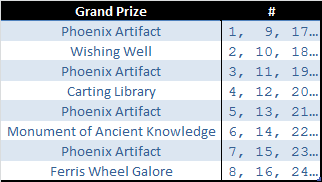
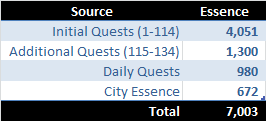
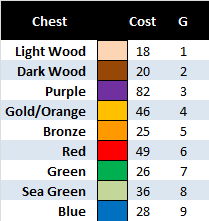
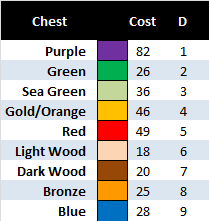
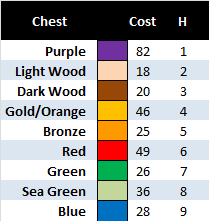
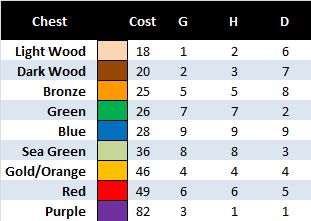

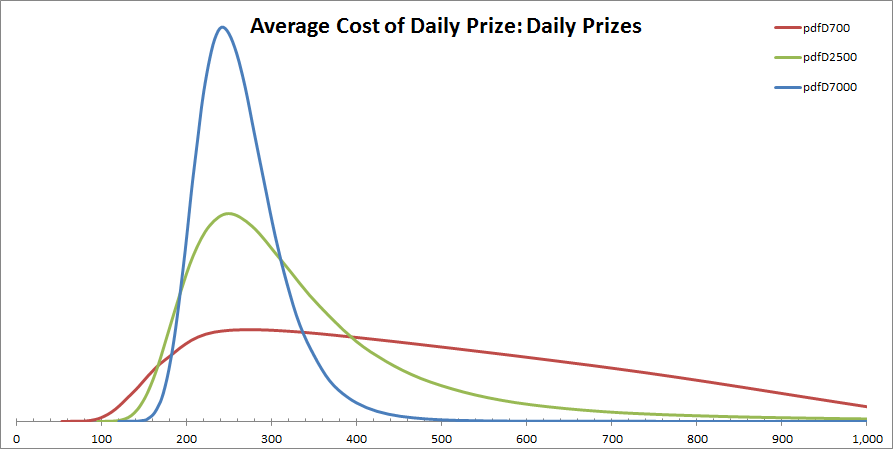

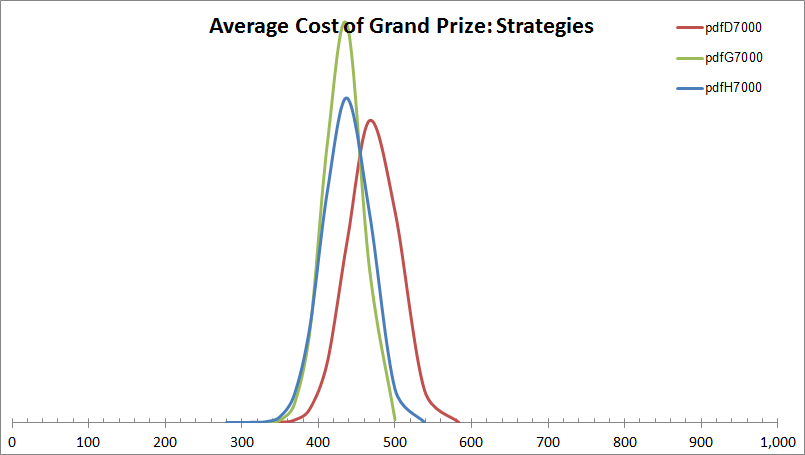
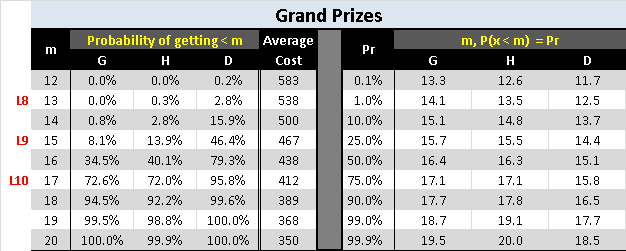

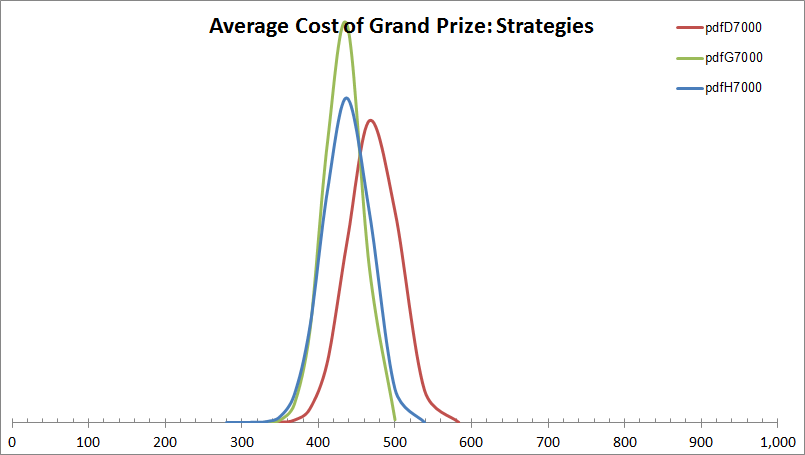
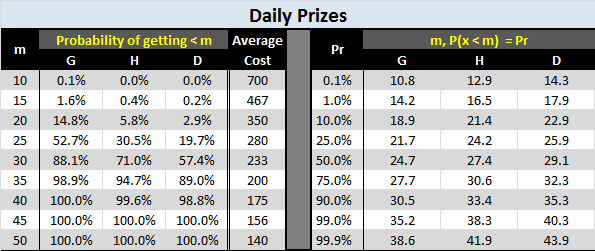
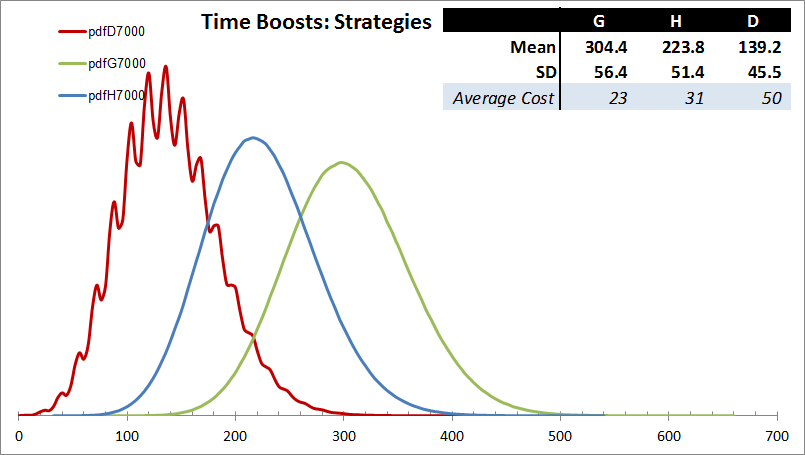
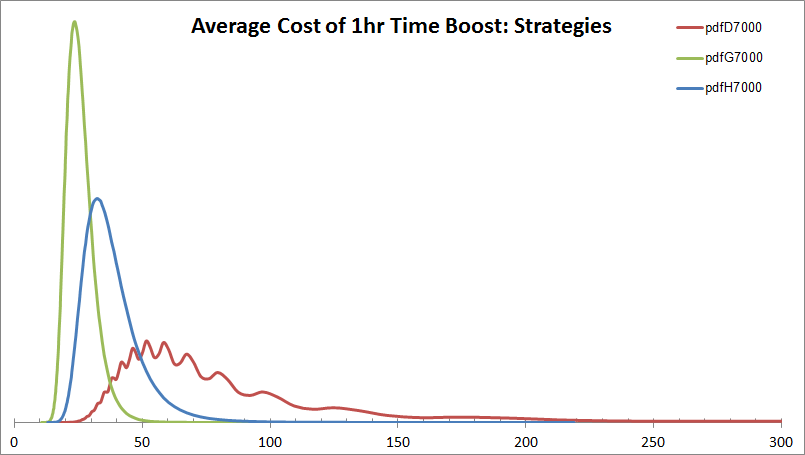
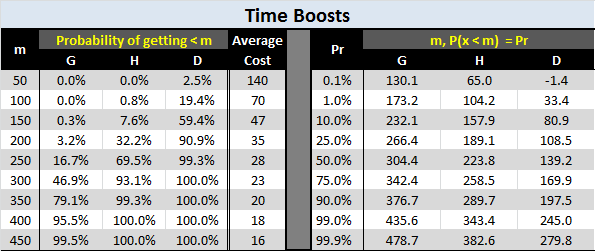
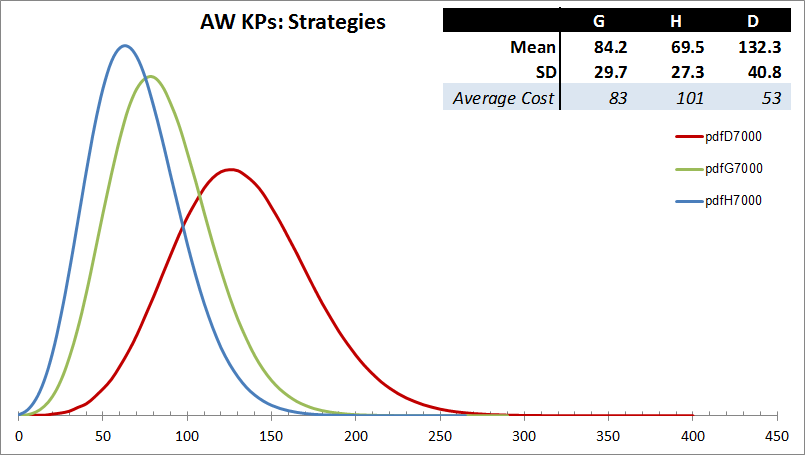
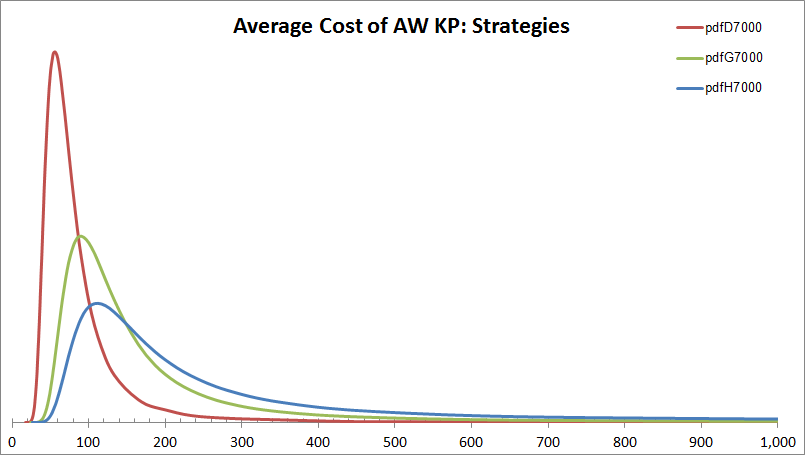
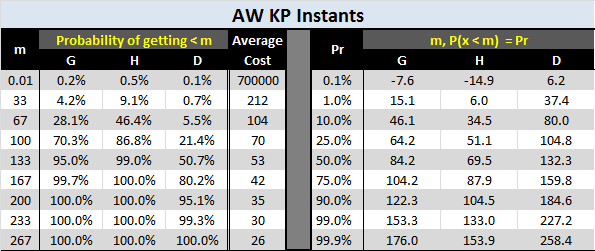
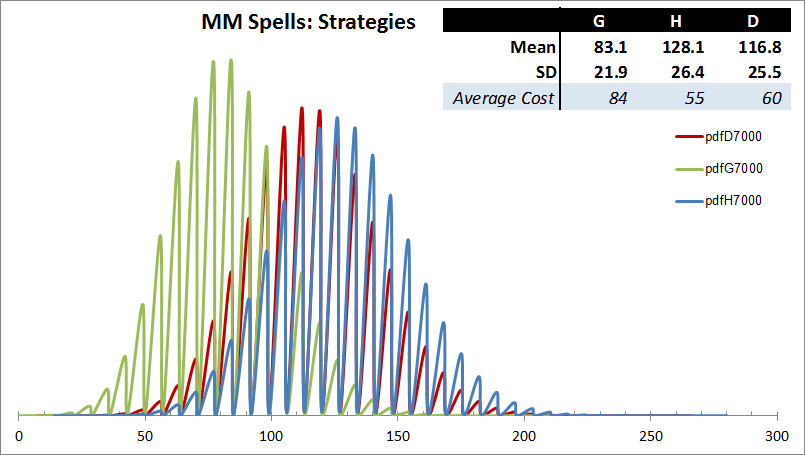


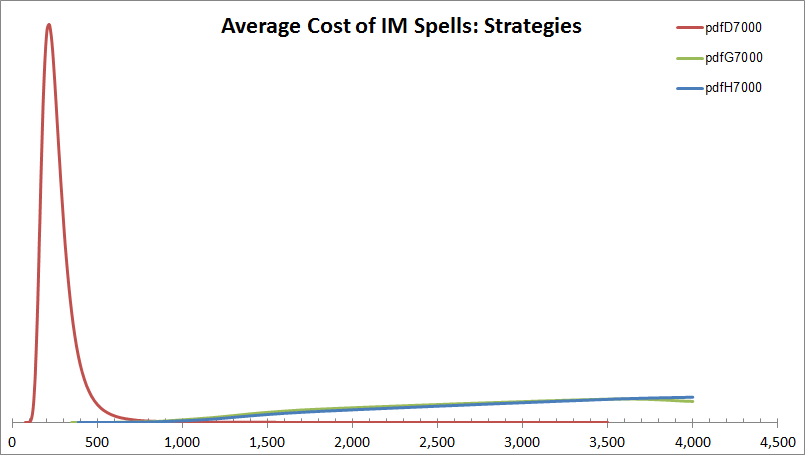
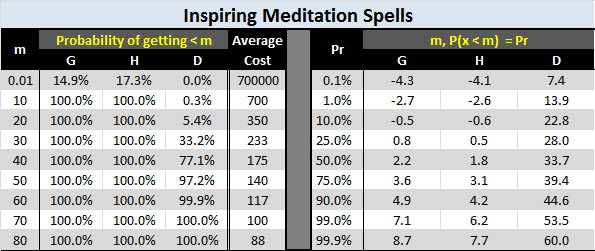
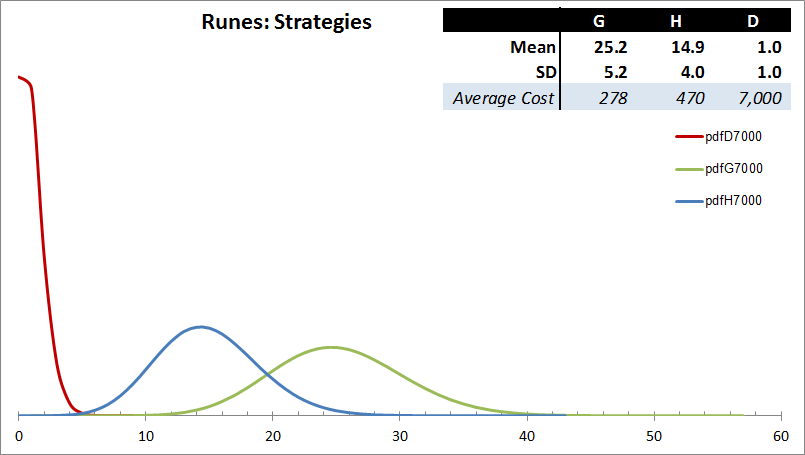
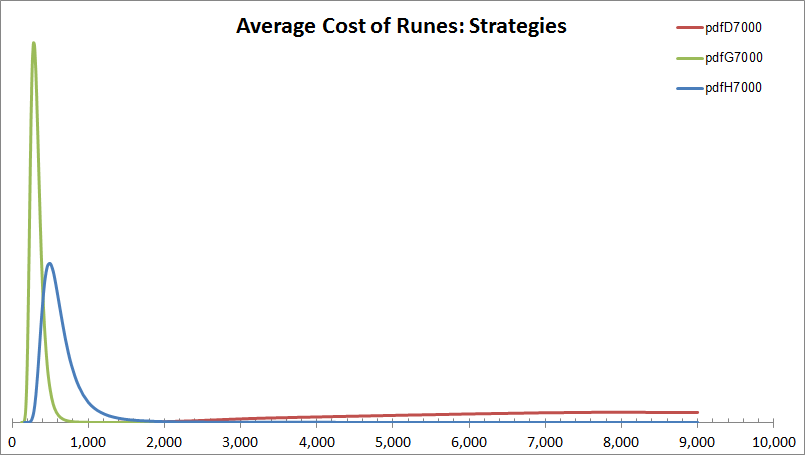
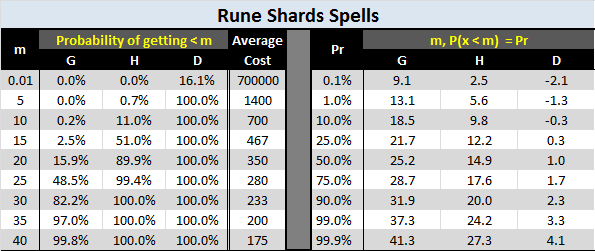
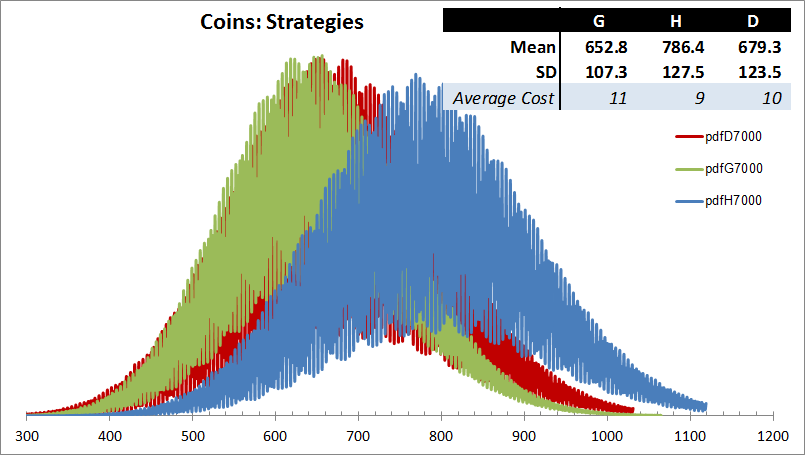
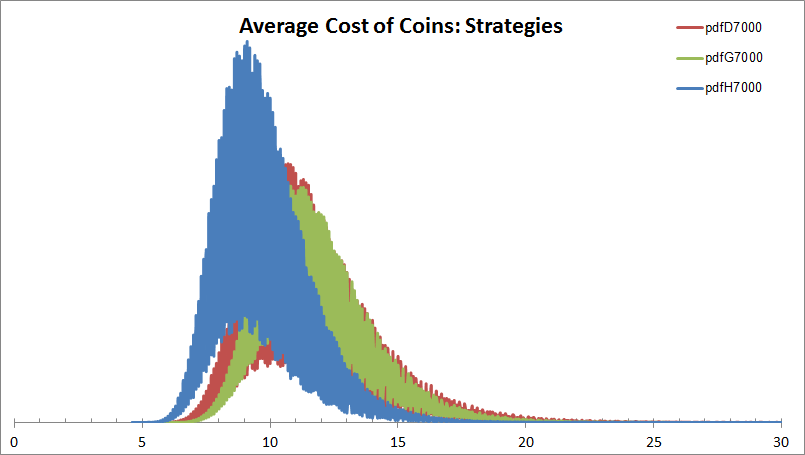
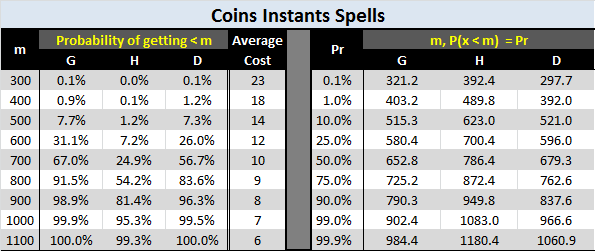
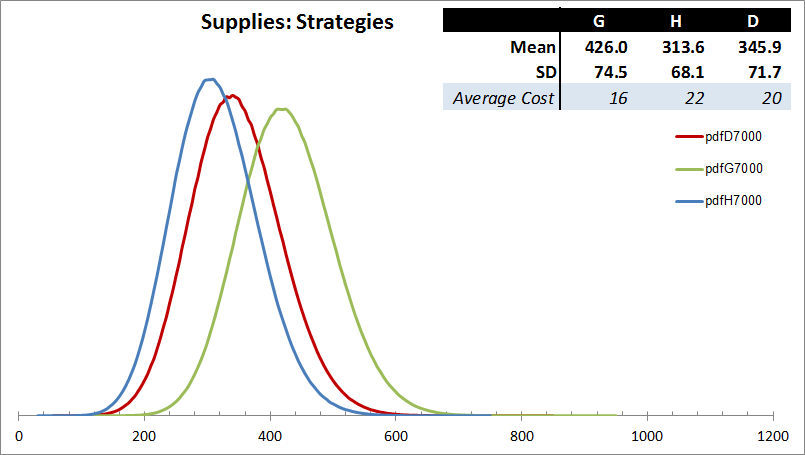
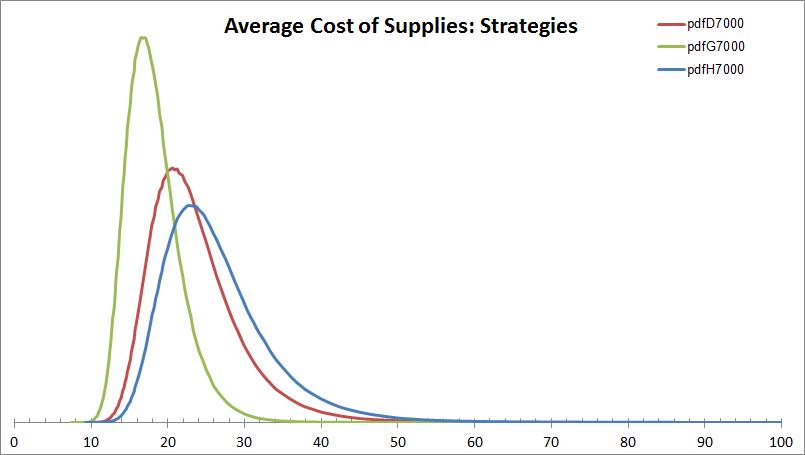
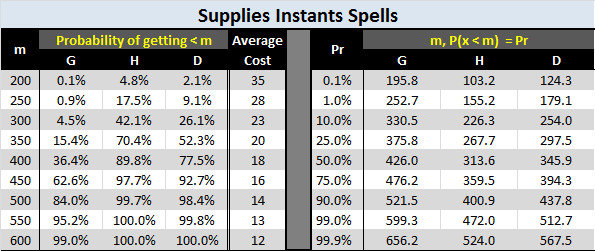

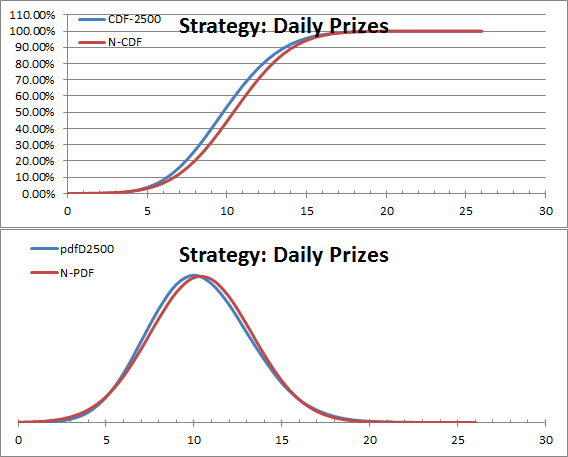
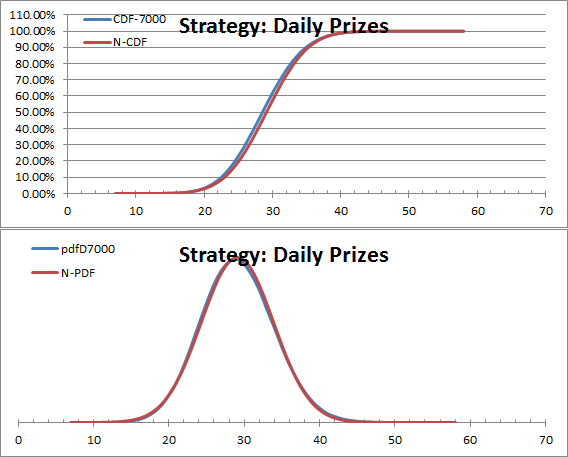
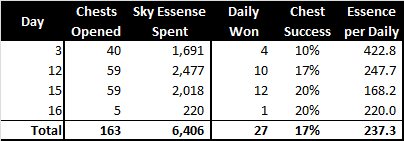


![Read more about the article Elvenar Woodelves – Day 13 [40%]](https://minmaxgame.com/wp-content/uploads/2019/03/WoodelvesFeaturedD13-300x113.png)
![Read more about the article Elvenar Sorcerers & Dragons – Day 19 [59%]](https://minmaxgame.com/wp-content/uploads/2019/04/SDFeaturedD19-300x113.png)
![Read more about the article Elvenar Woodelves – Day 09 [29%]](https://minmaxgame.com/wp-content/uploads/2019/03/WoodelvesFeaturedD09-300x113.png)
![Read more about the article Elvenar – Advanced Spire Tutorial [Level 1]](https://minmaxgame.com/wp-content/uploads/2020/04/SpireRequirementsFeatured-300x113.png)

![Read more about the article Elvenar Sorcerers & Dragons – Day 30 [84%]](https://minmaxgame.com/wp-content/uploads/2019/04/SDFeaturedD30-300x113.png)